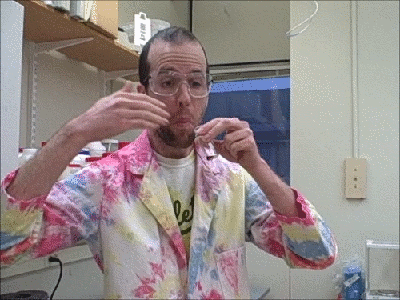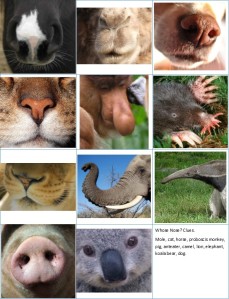When studying the five senses, there’s some great scent activities, but you may not want to do too many in one day. I personally get very headachey when exposed to too many scents in a short period, especially essential oils and artificial smells.
Exploring Smells, Noses-On
Scent bottles: First, you need airtight containers: You can use spice bottles from the dollar store where they have to flip the lid open to smell it (a small motor challenge for some), or ziplock bags, or yogurt containers with slits cut in the lid (kids can squeeze the sides and scented air will puff up through the slits in the lid), or two cups taped together with holes cut in the bottom.
Put in any of these items:
- fragrant foods – orange slice, slices of garlic, strong smelling cheese, coffee grounds, pickles, tuna, strawberries, cinnamon toast, popcorn
- fragrant non-foods: toothpaste, a cotton ball with perfume, a clorox wipe (has some chemical smell but not enough to be bad to smell), dishwashing detergent, dog or cat food, a scented candle or air freshener, play-doh, a Band-Aid, pine needles, rose petals, lavender
- spices or essential oils – dip a cotton ball in: cinnamon, curry powder, coconut oil, peppermint extract, lavender, vanilla, vinegar, rubbing alcohol
- Candies (jolly ranchers, chocolate, peppermints)
You can use these in three different ways:
- Pleasant or icky: kids smell and sort into baskets of “I like it” or “I don’t like it.”
- Guess the scent (need to use opaque containers so they can’t see it). Have photos of the items in the containers. Kids smell the container, then place it on the picture of the item they think it matches. When they’re done, they can open the containers to check their answers.
- Describe – ask them to describe the scent: include a sheet with vocabulary ideas like sour, sweet, sharp, tart, stinky, etc. (For older kids, teach scent specific vocabulary: Flowery, spicy, fruity, foul, burning, musky, citrus, herbal, sour, sharp, pungent, rancid, sweaty.)
In our class, we used spice bottles that they sorted into yummy and yucky, and had four dixie cups where they were asked to guess what was inside (toothpaste, pickle, cleaning cloth, and dog food).
Artificial scents: Bring in a variety of items with artificial scents. Do they smell like they’re supposed to? If something smells like food, does that mean it’s edible? If it’s a candy with a banana scent, then yes. But, if it’s lip balm, or a marker, or a scratch and sniff sticker, then no matter how much it smells like strawberries, it doesn’t mean it’s good to eat!
That smells bad! An interesting activity to put together would be bad smelling things: sour milk, over-ripe fruit, smelly permanent markers, sulfur, those “natural gas smell” cards that gas companies send out, bad smelling household chemicals…. be sure all the scents are safe to breathe in! Kids could smell them, and then talk about how bad smells can be a sign to us that something isn’t healthy for us to be around. The challenges with this activity would be to ensure there was nothing harmful about these scents. You’d also want to be able to get rid of the scents after the activity and not have them linger in the room!
Scent Memories: We know that certain scents can be very powerful in conjuring up memories for us. I’d love to come up with an activity that would play with that. I’m thinking a circle time activity where you’d open up a bag of fresh-popped popcorn and think about what memories you associate with that, or bring in some freshly baked chocolate chip cookies, and ask what the scent reminds you of… the trick would be to have a scent that would fill the room and evoke those memories.
Smelly Playdough: Make playdough (here’s our favorite play-dough recipe) and mix in small amounts of extracts such as vanilla, peppermint, cinnamon, anise. Color to match.
Outdoor Time: On a hike outdoors, have children smell the air, the plants, the ground, etc. (If you can’t go outdoors, bring the outdoors in, and have a smelling station with pine needles, flowers, soil, and more.)
Other Activities
Whose Nose? One of the big ideas for kids to get is that we use our nose to smell with. This free guessing game PDF shows several animal noses. See if your child / students can guess which animal is which.
Sensory tables: In the water table, add fragranced bubble bath, rose water, or lavender essential oil. For the sensory table, make cloud dough; flour, vegetable oil, and cocoa powder… smells like brownies!
Experiment in Habituation / Adaptation: In one container, mix 1 tsp cinnamon and 4 tsp vanilla extract. In the other container, mix 1 tsp cinnamon with 4 tsp water. Sniff the cinnamon vanilla mixture till you can’t smell it anymore. 6 – 10 sniffs? Immediately sniff the cinnamon-water till you can’t smell it. Then immediately sniff the cinnamon vanilla. Your nose will not detect the cinnamon because you’ve tired out the nerves that detect cinnamon – but your vanilla sensors are now ready to smell vanilla. (Idea from Cobb’s book, described below.)
Snack Time: Have kids plug their nose, then taste something. Then unplug it and taste it again. Is the taste experience different? Here’s a fun experiment: www.scientificamerican.com/article/bring-science-home-jelly-bean-taste-smell/
Share the ideas that smelling our food helps us enjoy it more. When we have a cold and our nose is plugged up, we don’t taste as much. Sometimes people lose their sense of smell due to injury or illness, and they enjoy food less.
Unsweetened Cocoa Use baker’s chocolate or cocoa powder. Have them smell it… mmm, chocolate! Then have them taste it. Yuck, bitter!!
Scent hike – tell about how animals use scent to track what they want to find. Tell them to imagine they are an animal that really loves to eat candy canes. As they go through the woods, they will search for the scent, and turn to follow it as they go. Then on the hike, everywhere you need to decide whether to turn right or left, place 2 dixie cups or scent bottles – one on the right hand path, one on the left. In one, have a cotton ball saturated in peppermint oil. In the other, have a plain cotton ball with no scent. They sniff both, and turn the way the peppermint tells them to turn. At the end of the hike, hand out mini candy canes to all.
Science of Smell: We smell something when it releases molecules into the air that we are breathing in – when the molecules reach the back of our nose, our brain interprets the scent to see if we can recognize it. Human beings recognize about 3000 – 10,000 odors, mostly either food cues or danger cues. There may be as many as 400,000 detectable odors. We smell through our nose, but we can also smell things we are holding in our mouths, as long as we don’t plug our nose… it’s the air circulation which brings the smell up into our nose. We smell things that are volatile – releasing molecules into the air. We don’t smell a metal object because it is not volatile.
Our sense of smell quickly habituates – when we first enter a room, we notice all the smells, but then over time our brain adapts to them and we stop noticing.
Our sense of smell protects us: we smell when something is burning so we can stay safe from fire. We notice when milk has soured and that prevents us from drinking the milk and getting sick.
More info for adults here: http://www.scienceinschool.org/2007/issue6/scents and here: http://health.howstuffworks.com/mental-health/human-nature/perception/question139.htm
Skills to teach – Sniffing and Wafting. Kids know how to sniff. Do they know why it works? It is easier to detect scent molecules in swirling air than in a smooth flow of air. So if we just inhale through our nose, we smell a little. If we sniff in air in little puffs, we detect more of the odor.
Wafting is a good skill to teach . If they’re smelling something for the first time, they may not want to bury their nose in it and take in a deep sniff. Instead, they can cup their hand, and use it to scoop some of the air from above the object up to their nose.

Book: Follow Your Nose: Discover Your Sense Of Smell by Vicki Cobb. It’s for ages 8 – 10, so way too old for my class, but it was an engaging read for me as an adult that really helped to ground me in the science of smell, so I could then better teach the kids.
For lots of great books about the five senses for preschool to first grade level, check out this post.





[…] Science of Smell for Kids […]
LikeLike
[…] Science of Smell for Kids […]
LikeLike
[…] Five Senses Unit: Overview, Hearing, Vision, Touch, Taste, Smell […]
LikeLike
[…] Five Senses Unit: Overview, Hearing, Vision, Touch, Taste, Smell […]
LikeLike
[…] Guess the scent: Blindfold your child and hold things up for them to smell. Can they guess what it is? […]
LikeLike
[…] 2- https://www.pinterest.com/pin/248120260700884228/ 3- https://www.highlightskids.com/explore/science-questions/how-do-flowers-get-their-scent 4- https://inventorsoftomorrow.com/2017/03/16/science-of-smell-for-kids/ […]
LikeLike
[…] Let them experience a variety of smells. Go for walks in the woods, go to a flower garden or an herb garden. Have them in the kitchen as you cook (let them smell the spices and herbs when you open the containers) and when you gather to eat, talk about how the food smells. “When I peel the orange, you can smell it, can’t you?” Try scented playdough, scented markers and stickers. Add scents to the bath water. (More scent activities.) […]
LikeLike